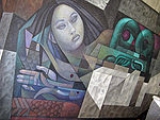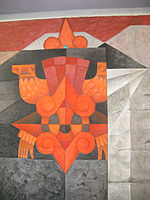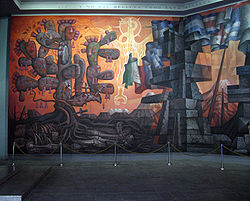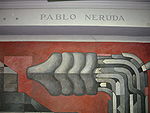
Presencia de América Latina
Encyclopedia
Presencia de América Latina (Presence of Latin America), also known as Integración de América Latina (Integration of Latin America) is a mural
painted by Mexican artist Jorge González Camarena
between November 1964 and April 1965. The 300-square-meter mural, painted in acrylic
on rough stucco
, is located in the lobby of the Casa del Arte of the University of Concepción (Ciudad Universitaria de Concepción), in Concepción
, Chile
. Its principal theme is the unity and brotherhood of the different Latin American cultures.
through the use of angular, symbolic images, which emphasize the value of fraternity between the different ethnicities of the Spanish American
world. The work is read chronologically from right to left.


 The right panel represents pre-Columbian America
The right panel represents pre-Columbian America
. On the lower part a woman with fish in her hands emerges from the Aztec pantheon
, symbolizing the riches of the sea. The woman is accompanied by the green mask of Tlaloc
, god of rain. Before her is Quetzalcoatl
, the serpent-shaped deity who symbolizes culture and who is depicted coiling around the staircase to the art gallery. On the upper part one can see Zontemoc ("The Falling Sun"), a god who symbolizes the twilight of pre-Hispanic culture. Completing this first panel of the mural, at the right is a mounted Spanish soldier, wearing armor and carrying a dagger, fighting against an eagle-man armed with a mace, symbolizing the battle of the conquest.
and Old World wheat
, nourishment that sustains the bases of industrialization, technology and science, represented as an intricate steel machine on the upper part of the panel.
At the center of the panel there are several overlapping faces, which symbolize the fusion of the races: the largest in red, represents the American race. Below these faces a life-sized, naked woman has a map of Latin America on her lap. She constitutes the principal subject matter of the mural.
On the woman one can see a capital
that symbolizes the Greco-Roman
contribution to Latin American culture; and a bit to the left, great blocks of solid rock, which create a great, vertical structure, symbolizing Mesoamerica
n architecture.
 On the left panel of the mural there is a nopal
On the left panel of the mural there is a nopal
, which merges with the vines of a copihue
(the national tree and flower of Mexico and Chile, respectively). The nopal is pierced by daggers, symbolizing the historic mistreatment of Latin Americans, and its roots entwine cadaverous warriors, who nourish the nopal and give it life.
 All along the top of the mural, the flags of the different Latin American nations wave in sequence. The sequence begins at the right with the flag of Chile
All along the top of the mural, the flags of the different Latin American nations wave in sequence. The sequence begins at the right with the flag of Chile
and a condor
, the national bird, and ends with the flag of Mexico
next to an eagle
and a serpent
, important national symbols of Mexico. The flags are organized from right to left, following the geographical placement of the nations from south to north. Thus the sequence begins with Chile, Argentina
, Uruguay
, Paraguay
, Bolivia
, Brazil
, Peru
, Ecuador
, Venezuela
and Colombia
of South America
; continues with Haiti
, Cuba
, Panama
, Costa Rica
, Honduras
, Nicaragua
and Guatemala
of Central America
and the Caribbean
; and ends with Mexico of North America
. The only peoples
excluded are those who are not sovereign
, that is, the French colonies of Clipperton Island
, Guadaloupe, French Guiana
, Martinique
, Saint Barthélemy
, and Saint Martin
—as well as the United States territory of Puerto Rico
.
The Andes
appears in the distant background, and crowing the entire mural are the verses of the Chilean poet, Pablo Neruda
:
. It is frequently visited by foreign and domestic tourists and reproduced in souvenir
s, book covers and catalogues, among other products. In 1994 it was depicted in a postage stamp
to commemorate the seventy-fifth anniversary of the University.
Mural
A mural is any piece of artwork painted or applied directly on a wall, ceiling or other large permanent surface. A particularly distinguishing characteristic of mural painting is that the architectural elements of the given space are harmoniously incorporated into the picture.-History:Murals of...
painted by Mexican artist Jorge González Camarena
Jorge González Camarena
Jorge González Camarena was a prominent Mexican painter, muralist and sculptor who received the Mexican National Prize for Arts and Sciences...
between November 1964 and April 1965. The 300-square-meter mural, painted in acrylic
Acrylic paint
Acrylic paint is fast drying paint containing pigment suspension in acrylic polymer emulsion. Acrylic paints can be diluted with water, but become water-resistant when dry...
on rough stucco
Stucco
Stucco or render is a material made of an aggregate, a binder, and water. Stucco is applied wet and hardens to a very dense solid. It is used as decorative coating for walls and ceilings and as a sculptural and artistic material in architecture...
, is located in the lobby of the Casa del Arte of the University of Concepción (Ciudad Universitaria de Concepción), in Concepción
Concepción, Chile
Concepción is a city in Chile, capital of Concepción Province and of the Biobío Region or Region VIII. Greater Concepción is the second-largest conurbation in the country, with 889,725 inhabitants...
, Chile
Chile
Chile ,officially the Republic of Chile , is a country in South America occupying a long, narrow coastal strip between the Andes mountains to the east and the Pacific Ocean to the west. It borders Peru to the north, Bolivia to the northeast, Argentina to the east, and the Drake Passage in the far...
. Its principal theme is the unity and brotherhood of the different Latin American cultures.
Structure of the mural
The mural is divided into three parts: a flat, central panel measuring 20 by 6 meters, and two sides panels set off at oblique angles to the central part. Each panel measures 7.6 by 6 meters. The mural as a whole is 211.2 m². In addition to this, the mural makes use of a staircase with right angles leading up to a second-story art gallery, increasing the total area to 300 m².Symbolism
The mural describes the history of Latin AmericaHistory of Latin America
Latin America refers to countries in the Americas where Romance languages are spoken. This definition, however, is not meant to include Canada, in spite of its large French-speaking population....
through the use of angular, symbolic images, which emphasize the value of fraternity between the different ethnicities of the Spanish American
Hispanic America
Hispanic America or Spanish America is the region comprising the American countries inhabited by Spanish-speaking populations.These countries have significant commonalities with each other and with Spain, whose colonies they formerly were...
world. The work is read chronologically from right to left.
Pre-Columbian culture



Pre-Columbian
The pre-Columbian era incorporates all period subdivisions in the history and prehistory of the Americas before the appearance of significant European influences on the American continents, spanning the time of the original settlement in the Upper Paleolithic period to European colonization during...
. On the lower part a woman with fish in her hands emerges from the Aztec pantheon
Aztec religion
Aztec religion is the Mesoamerican religion practiced by the Aztec empire. Like other Mesoamerican religions, it had elements of human sacrifice in connection with a large number of religious festivals which were held according to patterns of the Aztec calendar...
, symbolizing the riches of the sea. The woman is accompanied by the green mask of Tlaloc
Tlaloc
Tlaloc was an important deity in Aztec religion, a god of rain, fertility, and water. He was a beneficent god who gave life and sustenance, but he was also feared for his ability to send hail, thunder and lightning, and for being the lord of the powerful element of water. In Aztec iconography he...
, god of rain. Before her is Quetzalcoatl
Quetzalcoatl
Quetzalcoatl is a Mesoamerican deity whose name comes from the Nahuatl language and has the meaning of "feathered serpent". The worship of a feathered serpent deity is first documented in Teotihuacan in the first century BCE or first century CE...
, the serpent-shaped deity who symbolizes culture and who is depicted coiling around the staircase to the art gallery. On the upper part one can see Zontemoc ("The Falling Sun"), a god who symbolizes the twilight of pre-Hispanic culture. Completing this first panel of the mural, at the right is a mounted Spanish soldier, wearing armor and carrying a dagger, fighting against an eagle-man armed with a mace, symbolizing the battle of the conquest.
Miscegenation
The central panel begins a bit to the left of the first part with the Spanish soldier and a Native woman, the principal creators of miscegenation. Jorge González called this part The Original Couple ("La pareja original"), who walk over layers of coal, in which there are imprisoned, sleeping women, symbolizing the riches of the earth: silver, gold, iron and copper. On the surface of this swarm of bodies and precious stones, sprouts a pregnant woman covered with vines, representing the fertility of the earth. From her surge American cornMaize
Maize known in many English-speaking countries as corn or mielie/mealie, is a grain domesticated by indigenous peoples in Mesoamerica in prehistoric times. The leafy stalk produces ears which contain seeds called kernels. Though technically a grain, maize kernels are used in cooking as a vegetable...
and Old World wheat
Wheat
Wheat is a cereal grain, originally from the Levant region of the Near East, but now cultivated worldwide. In 2007 world production of wheat was 607 million tons, making it the third most-produced cereal after maize and rice...
, nourishment that sustains the bases of industrialization, technology and science, represented as an intricate steel machine on the upper part of the panel.
At the center of the panel there are several overlapping faces, which symbolize the fusion of the races: the largest in red, represents the American race. Below these faces a life-sized, naked woman has a map of Latin America on her lap. She constitutes the principal subject matter of the mural.
On the woman one can see a capital
Capital (architecture)
In architecture the capital forms the topmost member of a column . It mediates between the column and the load thrusting down upon it, broadening the area of the column's supporting surface...
that symbolizes the Greco-Roman
Greco-Roman world
The Greco-Roman world, Greco-Roman culture, or the term Greco-Roman , when used as an adjective, as understood by modern scholars and writers, refers to those geographical regions and countries that culturally were directly, protractedly and intimately influenced by the language, culture,...
contribution to Latin American culture; and a bit to the left, great blocks of solid rock, which create a great, vertical structure, symbolizing Mesoamerica
Mesoamerica
Mesoamerica is a region and culture area in the Americas, extending approximately from central Mexico to Belize, Guatemala, El Salvador, Honduras, Nicaragua, and Costa Rica, within which a number of pre-Columbian societies flourished before the Spanish colonization of the Americas in the 15th and...
n architecture.
Fraternity

Opuntia
Opuntia, also known as nopales or paddle cactus , is a genus in the cactus family, Cactaceae.Currently, only prickly pears are included in this genus of about 200 species distributed throughout most of the Americas. Chollas are now separated into the genus Cylindropuntia, which some still consider...
, which merges with the vines of a copihue
Copihue
Lapageria rosea, commonly known as the Copihue Lapageria rosea, commonly known as the Copihue Lapageria rosea, commonly known as the Copihue (co-pee-way Lapageria rosea, commonly known as the Copihue (co-pee-way...
(the national tree and flower of Mexico and Chile, respectively). The nopal is pierced by daggers, symbolizing the historic mistreatment of Latin Americans, and its roots entwine cadaverous warriors, who nourish the nopal and give it life.

Flag of Chile
The national flag of Chile, consists of two unequal horizontal bands of white and red and a blue square the same height as the white band in the canton, which bears a white five-pointed star in the center. It was adopted on October 18, 1817...
and a condor
Condor
Condor is the name for two species of New World vultures, each in a monotypic genus. They are the largest flying land birds in the Western Hemisphere.They are:* The Andean Condor which inhabits the Andean mountains....
, the national bird, and ends with the flag of Mexico
Flag of Mexico
The flag of Mexico is a vertical tricolor of green, white, and red with the national coat of arms charged in the center of the white stripe. While the meaning of the colors has changed over time, these three colors were adopted by Mexico following independence from Spain during the country's War...
next to an eagle
Eagle
Eagles are members of the bird family Accipitridae, and belong to several genera which are not necessarily closely related to each other. Most of the more than 60 species occur in Eurasia and Africa. Outside this area, just two species can be found in the United States and Canada, nine more in...
and a serpent
Snake
Snakes are elongate, legless, carnivorous reptiles of the suborder Serpentes that can be distinguished from legless lizards by their lack of eyelids and external ears. Like all squamates, snakes are ectothermic, amniote vertebrates covered in overlapping scales...
, important national symbols of Mexico. The flags are organized from right to left, following the geographical placement of the nations from south to north. Thus the sequence begins with Chile, Argentina
Argentina
Argentina , officially the Argentine Republic , is the second largest country in South America by land area, after Brazil. It is constituted as a federation of 23 provinces and an autonomous city, Buenos Aires...
, Uruguay
Uruguay
Uruguay ,officially the Oriental Republic of Uruguay,sometimes the Eastern Republic of Uruguay; ) is a country in the southeastern part of South America. It is home to some 3.5 million people, of whom 1.8 million live in the capital Montevideo and its metropolitan area...
, Paraguay
Paraguay
Paraguay , officially the Republic of Paraguay , is a landlocked country in South America. It is bordered by Argentina to the south and southwest, Brazil to the east and northeast, and Bolivia to the northwest. Paraguay lies on both banks of the Paraguay River, which runs through the center of the...
, Bolivia
Bolivia
Bolivia officially known as Plurinational State of Bolivia , is a landlocked country in central South America. It is the poorest country in South America...
, Brazil
Brazil
Brazil , officially the Federative Republic of Brazil , is the largest country in South America. It is the world's fifth largest country, both by geographical area and by population with over 192 million people...
, Peru
Peru
Peru , officially the Republic of Peru , is a country in western South America. It is bordered on the north by Ecuador and Colombia, on the east by Brazil, on the southeast by Bolivia, on the south by Chile, and on the west by the Pacific Ocean....
, Ecuador
Ecuador
Ecuador , officially the Republic of Ecuador is a representative democratic republic in South America, bordered by Colombia on the north, Peru on the east and south, and by the Pacific Ocean to the west. It is one of only two countries in South America, along with Chile, that do not have a border...
, Venezuela
Venezuela
Venezuela , officially called the Bolivarian Republic of Venezuela , is a tropical country on the northern coast of South America. It borders Colombia to the west, Guyana to the east, and Brazil to the south...
and Colombia
Colombia
Colombia, officially the Republic of Colombia , is a unitary constitutional republic comprising thirty-two departments. The country is located in northwestern South America, bordered to the east by Venezuela and Brazil; to the south by Ecuador and Peru; to the north by the Caribbean Sea; to the...
of South America
South America
South America is a continent situated in the Western Hemisphere, mostly in the Southern Hemisphere, with a relatively small portion in the Northern Hemisphere. The continent is also considered a subcontinent of the Americas. It is bordered on the west by the Pacific Ocean and on the north and east...
; continues with Haiti
Haiti
Haiti , officially the Republic of Haiti , is a Caribbean country. It occupies the western, smaller portion of the island of Hispaniola, in the Greater Antillean archipelago, which it shares with the Dominican Republic. Ayiti was the indigenous Taíno or Amerindian name for the island...
, Cuba
Cuba
The Republic of Cuba is an island nation in the Caribbean. The nation of Cuba consists of the main island of Cuba, the Isla de la Juventud, and several archipelagos. Havana is the largest city in Cuba and the country's capital. Santiago de Cuba is the second largest city...
, Panama
Panama
Panama , officially the Republic of Panama , is the southernmost country of Central America. Situated on the isthmus connecting North and South America, it is bordered by Costa Rica to the northwest, Colombia to the southeast, the Caribbean Sea to the north and the Pacific Ocean to the south. The...
, Costa Rica
Costa Rica
Costa Rica , officially the Republic of Costa Rica is a multilingual, multiethnic and multicultural country in Central America, bordered by Nicaragua to the north, Panama to the southeast, the Pacific Ocean to the west and the Caribbean Sea to the east....
, Honduras
Honduras
Honduras is a republic in Central America. It was previously known as Spanish Honduras to differentiate it from British Honduras, which became the modern-day state of Belize...
, Nicaragua
Nicaragua
Nicaragua is the largest country in the Central American American isthmus, bordered by Honduras to the north and Costa Rica to the south. The country is situated between 11 and 14 degrees north of the Equator in the Northern Hemisphere, which places it entirely within the tropics. The Pacific Ocean...
and Guatemala
Guatemala
Guatemala is a country in Central America bordered by Mexico to the north and west, the Pacific Ocean to the southwest, Belize to the northeast, the Caribbean to the east, and Honduras and El Salvador to the southeast...
of Central America
Central America
Central America is the central geographic region of the Americas. It is the southernmost, isthmian portion of the North American continent, which connects with South America on the southeast. When considered part of the unified continental model, it is considered a subcontinent...
and the Caribbean
Caribbean
The Caribbean is a crescent-shaped group of islands more than 2,000 miles long separating the Gulf of Mexico and the Caribbean Sea, to the west and south, from the Atlantic Ocean, to the east and north...
; and ends with Mexico of North America
North America
North America is a continent wholly within the Northern Hemisphere and almost wholly within the Western Hemisphere. It is also considered a northern subcontinent of the Americas...
. The only peoples
Ethnic group
An ethnic group is a group of people whose members identify with each other, through a common heritage, often consisting of a common language, a common culture and/or an ideology that stresses common ancestry or endogamy...
excluded are those who are not sovereign
Sovereignty
Sovereignty is the quality of having supreme, independent authority over a geographic area, such as a territory. It can be found in a power to rule and make law that rests on a political fact for which no purely legal explanation can be provided...
, that is, the French colonies of Clipperton Island
Clipperton Island
Clipperton Island is an uninhabited nine-square-kilometre coral atoll in the eastern Pacific Ocean, southwest of Mexico and west of Central America, at...
, Guadaloupe, French Guiana
French Guiana
French Guiana is an overseas region of France, consisting of a single overseas department located on the northern Atlantic coast of South America. It has borders with two nations, Brazil to the east and south, and Suriname to the west...
, Martinique
Martinique
Martinique is an island in the eastern Caribbean Sea, with a land area of . Like Guadeloupe, it is an overseas region of France, consisting of a single overseas department. To the northwest lies Dominica, to the south St Lucia, and to the southeast Barbados...
, Saint Barthélemy
Saint Barthélemy
Saint Barthélemy , officially the Territorial collectivity of Saint Barthélemy , is an overseas collectivity of France. Often abbreviated to Saint-Barth in French, or St. Barts in English, the indigenous people called the island Ouanalao...
, and Saint Martin
Saint Martin (France)
Saint Martin , officially the Collectivity of Saint Martin is an overseas collectivity of France located in the Caribbean. It came into being on 15 July 2007, encompassing the northern parts of Saint Martin island and neighbouring islets, the largest of which is Île Tintamarre...
—as well as the United States territory of Puerto Rico
Puerto Rico
Puerto Rico , officially the Commonwealth of Puerto Rico , is an unincorporated territory of the United States, located in the northeastern Caribbean, east of the Dominican Republic and west of both the United States Virgin Islands and the British Virgin Islands.Puerto Rico comprises an...
.
The Andes
Andes
The Andes is the world's longest continental mountain range. It is a continual range of highlands along the western coast of South America. This range is about long, about to wide , and of an average height of about .Along its length, the Andes is split into several ranges, which are separated...
appears in the distant background, and crowing the entire mural are the verses of the Chilean poet, Pablo Neruda
Pablo Neruda
Pablo Neruda was the pen name and, later, legal name of the Chilean poet, diplomat and politician Neftalí Ricardo Reyes Basoalto. He chose his pen name after Czech poet Jan Neruda....
:
…There is no beauty like the beauty of America spread out in its hells / in its mountains of rock and power, in its atavistic and eternal rivers…
(…Y no hay belleza como esta belleza de América extendida en sus infiernos / en sus cerros de piedra y poderío, en sus ríos atávicos y eternos…)
Symbol of the University and Concepción
Along with the clock tower of the University of Concepción, the mural Presencia de América Latina is a true symbol of the culture of ConcepciónConcepción, Chile
Concepción is a city in Chile, capital of Concepción Province and of the Biobío Region or Region VIII. Greater Concepción is the second-largest conurbation in the country, with 889,725 inhabitants...
. It is frequently visited by foreign and domestic tourists and reproduced in souvenir
Souvenir
A souvenir , memento, keepsake or token of remembrance is an object a person acquires for the memories the owner associates with it. The term souvenir brings to mind the mass-produced kitsch that is the main commodity of souvenir and gift shops in many tourist traps around the world...
s, book covers and catalogues, among other products. In 1994 it was depicted in a postage stamp
Postage stamp
A postage stamp is a small piece of paper that is purchased and displayed on an item of mail as evidence of payment of postage. Typically, stamps are made from special paper, with a national designation and denomination on the face, and a gum adhesive on the reverse side...
to commemorate the seventy-fifth anniversary of the University.

